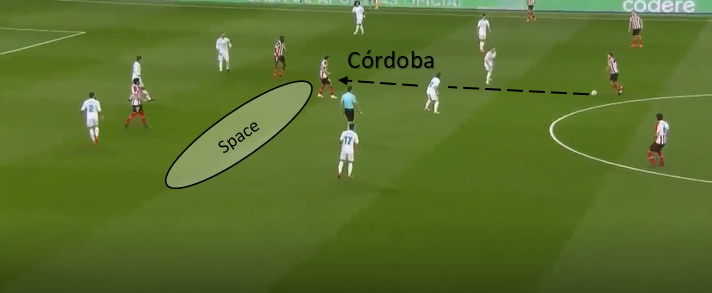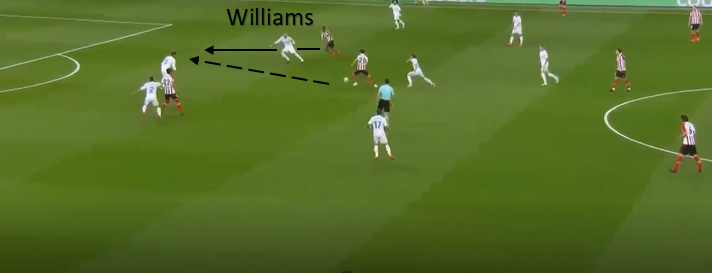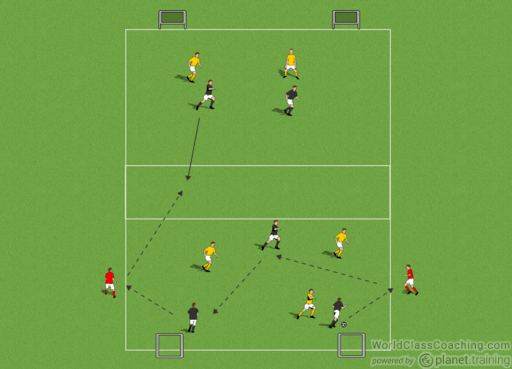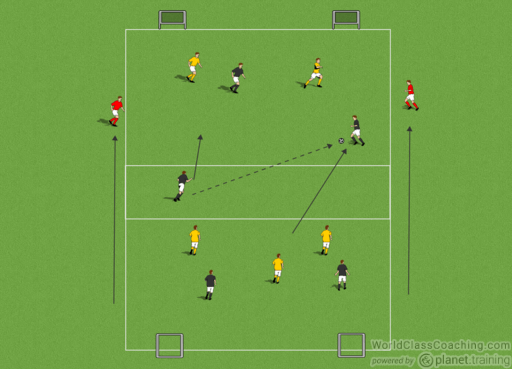By Philip Joe Cauchi
When a striker drops between the lines, questions arise for the defender concerned. Should the defender follow the striker? Or, should the defender remain inside his/her zone of responsibility? If the defender follows the striker, a gap is created in the defence unit which the attacking team might be able to exploit. On the other hand if the defender remains with the back line, the striker dropping between the midfield and defence units has time to receive, turn and combine with the other strikers, or with the midfielders joining the attack. Moving between the lines is an effective tactic for strikers to free themselves of marking and create havoc in the opponents’ back line. This is even more effective if the opponents are playing with a rear block of two flat lines as is shown in figure 1 below.

Figure 1: Córdoba inserts himself between the defence and midfield lines. Real Madrid’s two central midfielders are unaware of Córdoba’s position and are also square. Being square makes the angle of a pass bigger, and a successful line breaking pass is played to Córdoba’s feet.

Figure 2: Applying a positive stance and being aware of his position before receiving the ball, enabled Córdoba to receive and play a quick through pass to Williams, who cut inside from the defender’s blind side to score Athletic Bilbao’s goal in a 1-1 tie.
Training situation: Drop between the lines to finalise the attack.
Setup: We have a high zone and a low zone both measuring approximately 15 by 20 yards. Areas may vary according to the technical-tactical ability level of the players. A middle zone measuring 3 by 20 yards separates the high and low zones. We have two teams of five plus two neutral players. In the low zone we have three midfielders for both teams while in the high zone we have two central defenders (yellows) and two strikers (blacks). The two neutral (reds) players play as full backs along the flanks.
Execution: When the ball is out of play it always starts from the attacking team (black) in the low zone. The attacking team aims to play a pre-set number of passes before passing the ball to one of the two strikers who comes short in the middle zone. The striker has approximately a maximum of three seconds to receive the ball and play, otherwise s/he has to move out of the zone. The defending team may counter on the opposite small goals should they win possession of the ball.
Once receiving the ball in the middle zone the attacker can turn forward to either dribble or pass to the other striker or the midfielder who joins the attack. The neutral full backs also join the attack to make it a 5v2. The attacker receiving the ball in the middle zone cannot be tackled inside this zone.

Figure 3: A realistic build-up from midfield by the black team with the strikers staying high in order to create space between the opposition’s midfield and defence. Once a forward pass is on, the striker closest to the ball drops in the middle channel to receive.

Figure 4: Coaching the details – the striker should adapt an open body stance that enables him/her to play forward at speed.
Progressions:
1. A defender tracks back when the ball is played into the high zone, making the situation a 5v3 in favour of the attackers inside this zone.
2. Once the ball is played into the high zone, the attackers have 15 seconds to score.
3. The striker dropping into the middle zone may be pressured and tackled by a defender.
4. Play without neutral players.
Philip Joe Cauchi works as performance coach in Malta. He holds a UEFA A and a UEFA A Youth Elite coaching licences as well as a B.ed (Hons) in Education with Physical Education and is also a qualified football conditioning coach.


